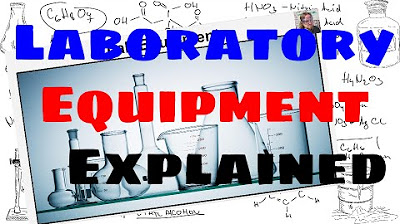1.4 Common Laboratory Equipment (headless woman)
Summary
TLDRIn this lab equipment tutorial, the instructor introduces various essential tools for chemistry experiments. Key items include graduated cylinders for precise liquid measurements, Erlenmeyer flasks, and beakers for rough estimates. Other tools like test tubes, stirring rods, mortar and pestle, crucibles, and Bunsen burners are highlighted for specific uses. Safety is emphasized with the use of goggles and proper handling of equipment. The video also covers the use of a balance, test tube holders, tongs, and a ceramic tile for heating substances safely.
Takeaways
- 👓 Safety is paramount in the lab, hence the use of goggles when working with glassware or chemicals.
- 🧪 Graduated cylinders are essential for accurately measuring liquids, with sizes ranging from 10ml to 255ml.
- 🧫 Erlenmeyer flasks are versatile for holding liquids and solids, but not ideal for precise measurements.
- 🥣 Beakers come in various sizes, such as 250ml, 100ml, and 50ml, and are used for rough liquid volume estimation.
- 🧪 Test tubes are used for small-scale reactions and require a test tube holder for heating.
- 🔬 A mortar and pestle are used for grinding solid materials, such as crystals, into finer forms.
- 🔥 A crucible and cover are used for heating and removing liquids from solids to dehydrate them.
- 🧪 A well plate allows for conducting multiple reactions simultaneously in individual wells.
- 🌀 A funnel is used in conjunction with filter paper for filtering liquids.
- 🔬 A balance, not a scale, is used in labs for precise measurements of substances.
- 🔥 Bunsen burners are used for heating substances in the lab, operated with natural gas and lit with a striker.
Q & A
Why do we wear goggles in the lab?
-We wear goggles in the lab anytime we work with fire, glass, or any kind of chemicals to protect our eyes from potential hazards.
What is a graduated cylinder and how is it used?
-A graduated cylinder is a piece of laboratory equipment used for measuring the volume of liquids. It has marked graduations indicating volume measurements, allowing for accurate liquid volume measurement.
What are the different sizes of graduated cylinders mentioned in the script?
-The script mentions graduated cylinders of 100ml, 250ml, and 10ml sizes.
What is an Erlenmeyer flask and how is it used?
-An Erlenmeyer flask is used for containing liquids, possibly solids, and is not a precise measuring device but can give an estimate of the volume of liquids it contains.
What is the purpose of a beaker in a laboratory setting?
-A beaker is used for holding and mixing substances, and although it is not very accurate for precise measurements, it can provide a rough estimate of liquid volume.
What is the capacity of the 50ml beaker mentioned in the script?
-The 50ml beaker mentioned in the script is actually marked as 40ml, which is the capacity that can be accurately measured.
What is the function of a test tube holder?
-A test tube holder is used to securely hold test tubes in place, especially when heating them over a Bunsen burner.
What is the purpose of a mortar and pestle in a lab?
-A mortar and pestle are used to grind materials, often solid substances that come in crystal form, to a finer consistency.
What is a crucible and cover used for?
-A crucible and cover are used for dehydration, often to remove liquids from solids by heating them.
What is the use of a well plate in a laboratory?
-A well plate is used to conduct reactions in each of its individual wells, allowing for multiple reactions to be carried out simultaneously.
What is the function of a Bunsen burner in a lab?
-A Bunsen burner is used to provide a controlled heat source in the laboratory, often for heating substances or equipment.
What is the difference between a spatula and a scoopula?
-Both a spatula and a scoopula are used to transfer solids, but a scoopula is larger and often used for transferring larger amounts or bulk substances.
What is the purpose of a ceramic tile in a lab?
-A ceramic tile is used as a heat-resistant surface to place hot equipment on, preventing damage to the lab bench or table.
What is the difference between beaker tongs and crucible tongs?
-Beaker tongs are designed to handle beakers and other larger glassware, while crucible tongs are used for smaller, heat-resistant items like crucibles or watch glasses. Crucible tongs should not be used in a flame as they can be damaged.
Outlines

Cette section est réservée aux utilisateurs payants. Améliorez votre compte pour accéder à cette section.
Améliorer maintenantMindmap

Cette section est réservée aux utilisateurs payants. Améliorez votre compte pour accéder à cette section.
Améliorer maintenantKeywords

Cette section est réservée aux utilisateurs payants. Améliorez votre compte pour accéder à cette section.
Améliorer maintenantHighlights

Cette section est réservée aux utilisateurs payants. Améliorez votre compte pour accéder à cette section.
Améliorer maintenantTranscripts

Cette section est réservée aux utilisateurs payants. Améliorez votre compte pour accéder à cette section.
Améliorer maintenantVoir Plus de Vidéos Connexes

Common Scientific Glassware and the Undergraduate Chemistry Laboratory

ALAT ALAT LABORATORIUM KIMIA DAN KEGUNAANNYA - MATERI KIMIA SMA KELAS X

Pengenalan Alat Laboratorium

Lab Equipment - Explained

Lab Tools and Equipment - Know your glassware and become an expert Chemist! | Chemistry

20 most important apparatus used in chemistry lab | chemistry lab apparatus name with picture
5.0 / 5 (0 votes)
